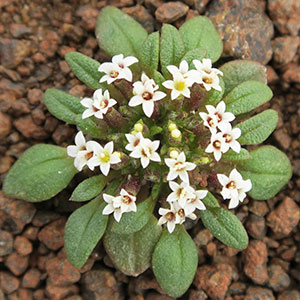Dimeresia howellii
Dimeresia
dimeresia, doublet
dimeresia, doublet
decumbent to erect.
blades (2–)10–30+ mm, initially cobwebby, glabrescent, often gland-dotted.
basal and/or cauline; opposite (crowded, seemingly whorled);
subsessile or ± petiolate;
blades spatulate to oblanceolate, entire.
cylindric to obconic, 2(–4) mm diam.
minute, epaleate.
0.
2(–3), bisexual, fertile;
corollas white, pink, or purple, tubes slightly shorter than funnelform throats, lobes 5, deltate-ovate.
5–6 mm.
2(–3) in 1 series (basally distinct or connate, oblong, herbaceous).
discoid, in clusters (of 2–5, congested, total heads to 100+).
2–3 mm;
pappi 3–4 mm (bristles falling together).
cylindric to clavate, striate, glabrous;
pappi falling, of ca. 20 basally connate, setiform to subulate, ± plumose scales (or flattened bristles).
= 7.
= 14.
Dimeresia howellii
Dimeresia
Species 1.
(Discussion copyrighted by Flora of North America; reprinted with permission.)


